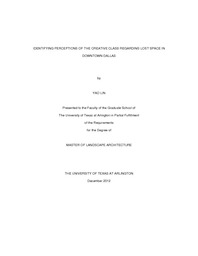
ATTENTION: The works hosted here are being migrated to a new repository that will consolidate resources, improve discoverability, and better show UTA's research impact on the global community. We will update authors as the migration progresses. Please see MavMatrix for more information.
Show simple item record
| dc.contributor.author | Lin, Yao | en_US |
| dc.date.accessioned | 2013-03-20T19:10:37Z | |
| dc.date.available | 2013-03-20T19:10:37Z | |
| dc.date.issued | 2013-03-20 | |
| dc.date.submitted | January 2012 | en_US |
| dc.identifier.other | DISS-11991 | en_US |
| dc.identifier.uri | http://hdl.handle.net/10106/11509 | |
| dc.description.abstract | This thesis deals with perceptions held by members of the "creative class" (Florida 2004) regarding lost space (Trancik 1986) in downtown Dallas, Texas. Data from this study come from face-to-face interviews with end-users (the creative class) of lost space, and the results of the study offer insight on design and use of these spaces, so common to contemporary human communities. Trancik (1986) argues that lost space consists of undesirable and seemingly useless urban spaces, which because they are problematic, need to be redesigned. Trancik contrasts the urban voids of lost space with positive urban spaces which he defines as those with "traditional values and meaning" (p. vii). However, Trancik's examples of what constitutes "undesirable" and "useless" space, such as a parking lot, are not consistent with the perceptions of end-users in a contemporary urban environment (Visser 2010), meaning that which specific urban areas are "lost" and which are "positive" is not clear. In fact, Trancik projects his personal values and meanings into the definition of lost space, which in this research is considered to be prescriptive lost space, rather than seeking an understanding of positive urban space from the perspective of end-users, which in this research is considered to be descriptive lost space. Past research on lost space suggests that it is important to consider end-users' perceptions of their environment because space only becomes place when it is given contextual meaning by end-users (Jacobs 1961; Trancik 1986; Whyte 1988; Fields 2005). However, little of this past research includes interviews with end-users, leaving the characteristics of descriptive lost space poorly defined.Indeed, having a more complete understanding of the characteristics of descriptive lost space is important to design a world in which end-users perceive their own values and meanings in urban areas. Therefore, this research investigates the characteristics of lost space according to end-users' experiences by searching for distinctions between prescriptive and descriptive lost space. Because the most insightful characteristics of descriptive lost space come from end-users who are highly involved in a city's economic, technological, and social structures, whom Florida (2004) calls the creative class. According to Boden (2004), creativity creates a heightened ability to sense unique patterns in the environment; therefore, Florida suggests the creative class has more opportunity to drive positive changes in its surroundings, meaning that urban designers can benefit from the perceptions held by these end-users. While knowing end-users' perceptions of lost space is not a cure-all to the problem of urban lost space, it can nonetheless provide planners and designers with new insights to better capture the essence of urban space while filling holes in the urban fabric. | en_US |
| dc.description.sponsorship | Taylor, Pat D. | en_US |
| dc.language.iso | en | en_US |
| dc.publisher | Landscape Architecture | en_US |
| dc.title | Identifying Perceptions Of The Creative Class Regarding Lost Space In Downtown Dallas | en_US |
| dc.type | M.L.A. | en_US |
| dc.contributor.committeeChair | Taylor, Pat D. | en_US |
| dc.degree.department | Landscape Architecture | en_US |
| dc.degree.discipline | Landscape Architecture | en_US |
| dc.degree.grantor | University of Texas at Arlington | en_US |
| dc.degree.level | masters | en_US |
| dc.degree.name | M.L.A. | en_US |
Files in this item
- Name:
- Lin_uta_2502M_11991.pdf
- Size:
- 5.448Mb
- Format:
- PDF
This item appears in the following Collection(s)
Show simple item record


